Flavor, texture and easy to pull together, this delicious Gluten Free Sourdough Pizza Crust is a pizza night game changer! Use your Gluten Free Sourdough Starter discard to whip up a crispy, chewy and flavorful pizza. This recipe is make ahead ready, freezer friendly, vegetarian and a gluten free vegan sourdough pizza crust! For a non-sourdough crust, try my similar Gluten Free Pizza Crust. | This post is brought to you by Bob’s Red Mill.
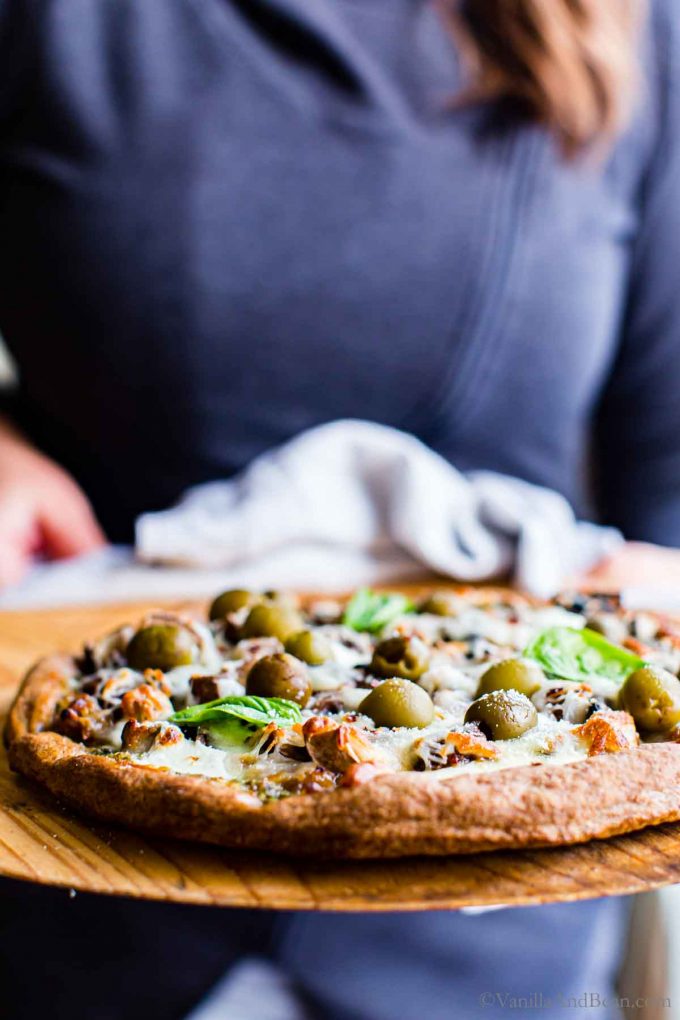
Table of Contents
A Gluten Free Sourdough Pizza Journey
After going gluten free for a trial, I developed a gluten free sourdough starter recipe to use in this seeded gluten free sourdough bread. Discard recipes followed. After receiving requests from Vanilla And Bean makers for a gluten free sourdough pizza recipe, I got to work. So, you can imagine there have been many iterations of this delicious gluten free sourdough pizza base recipe.
I’m back to my glutenous ways, but come to find out, Rob (my husband) prefers my gluten free pizza crust over my sourdough pizza crust recipe (I know, right?). After lots of testing and tweaking I’m excited to be sharing my best gluten free pizza dough, sourdough style, with y’all!
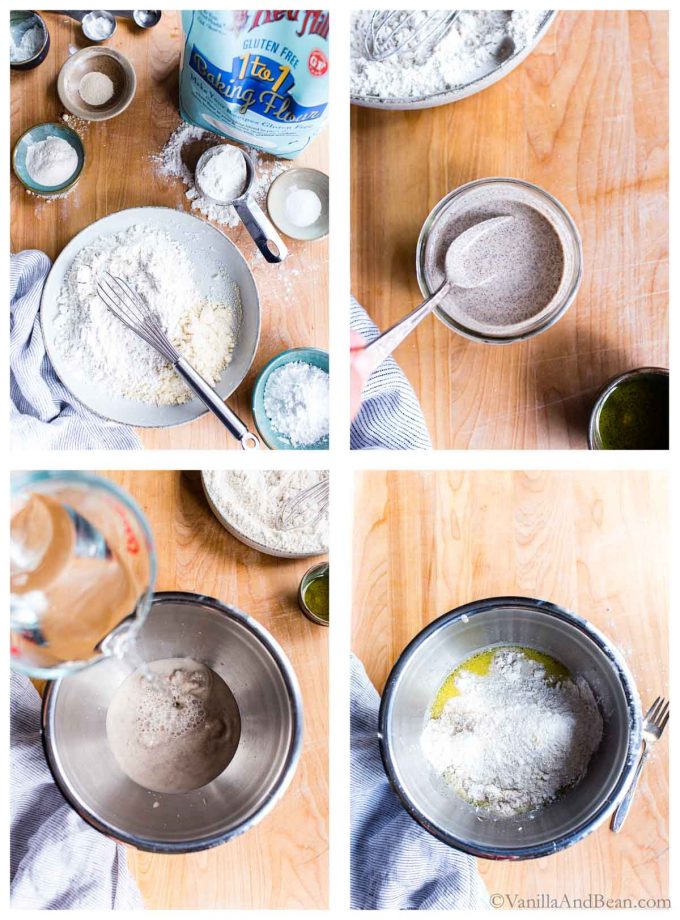
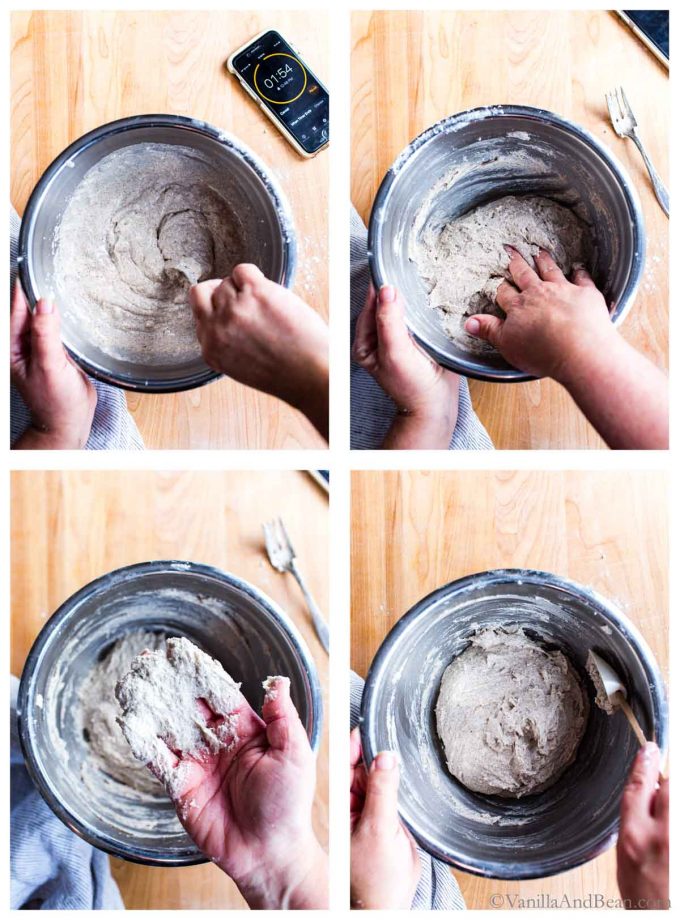
Ingredients Make All the Difference
Choosing high quality ingredients is important for flavor and health. It’s a reflection of the love and attention that goes into each recipe I create for my family, friends and the Vanilla And Bean community.
Bob’s Red Mill Gluten Free 1-to-1 Baking Flour is perfect for everyday. It’s a blend of white and brown rice flour and other gluten-free flours, starches, and xanthan gum. It’s helped me create light and fluffy cupcakes, pastry for apple pie and pumpkin pie, tasty cornbread and an absolutely fabulous homemade gluten free pizza dough recipe!
Using Bob’s Red Mill Gluten Free 1-to-1 Baking Flour and Almond Flour in this gluten free sourdough discard pizza dough recipe is a delicious way to create fabulous homemade pizza sans gluten and to enjoy that sourdough flavor we love without wasting discard.
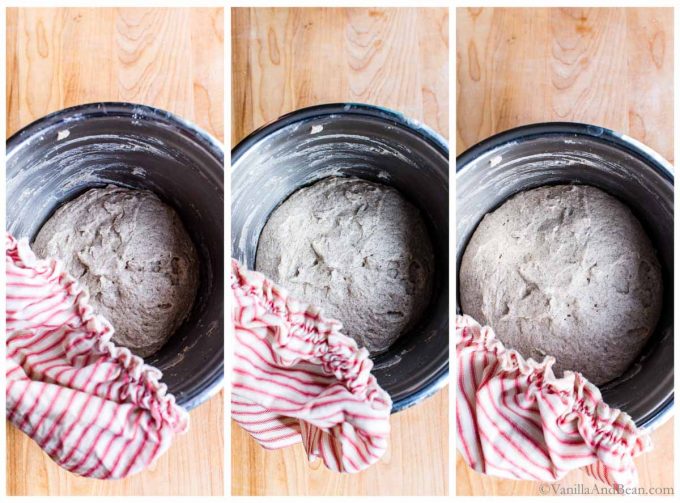
Quick Guide: How to Make Sourdough Gluten Free Pizza Crust in Five Easy Steps
This gluten free pizza crust recipe yields 2 10″-11″ Pizzas. If you’d like to freeze one or both for later, do-so after par baking, then thaw at room temperature just prior to topping the pizza and baking. In summary, here’s how to make sourdough discard pizza crust (see recipe card for details):
- First: mix warm water, sourdough discard and olive oil.
- Second: into the water mixture, add all purpose 1:1 gluten free flour, almond flour, psyllium husk powder, tapioca flour, salt, quick rise yeast and baking powder all at once.
- Third: mix throughly, then set it and forget it for about 90 minutes to allow the to dough rise.
- Fourth: shape the pizza dough on oiled parchment paper.
- Last: pop the shaped dough in the oven for par baking!
It’s almost ready! …now, pile on the toppings de jour and bake the pizza for about 8 minutes.
Pour your favorite beverage and enjoy the best sourdough gluten free pizza!
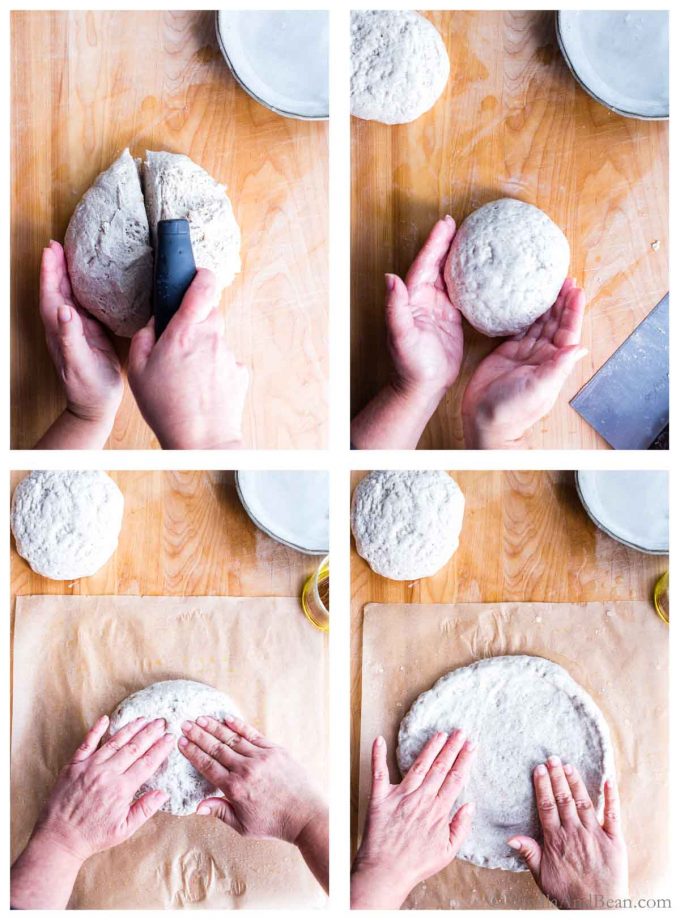
About the Ingredients
- Sourdough Discard: I’m using my Gluten Free Sourdough Starter recipe in this pizza recipe. The sourdough starter is 130% hydration. If you use a lower hydration discard, you may need to add a bit more water.
- Gluten Free Flour Blend: I use Bob’s Red Mill 1:1 Baking Flour in this recipe. It complements the sourdough and contributes to a crispy/chewy pizza crust texture.
- Almond Flour: Bob’s Red Mill Super Fine Almond Flour bumps up the protein for structure and contributes to the earthy flavors sourdough is known for.
- Tapioca Flour: Assists in a crisp texture in part and helps manage water in this high hydration dough.
- Psyllium Husk Powder: Bob’s Red Mill has discontinued their psyllium husk powder, which is the brand I’ve used for a long time in this and other gluten free recipes. Because of this, I’ve transitioned to using Terrasoul Superfoods psyllium husk powder and found I needed to reduce the amount because it’s a much finer powder. Otherwise, if I subbed one-to-one, it made the dough too thick/gummy (difficult to shape). I’ve learned the finer the powder, the less is needed in the recipe. I’ve included both amounts in this recipe if you still have some Bob’s Red Mill PHP on hand (see notes on recipe card).
- Psyllium husk powder contributes to binding and a chewy texture in this egg free gluten free pizza recipe so I do not recommend subbing this ingredient. Be sure to use psyllium husk powder rather than whole husks.
- Quick Rise Yeast: aka Rapid Rise or Instant Yeast aids in flavor development and leavening the dough.
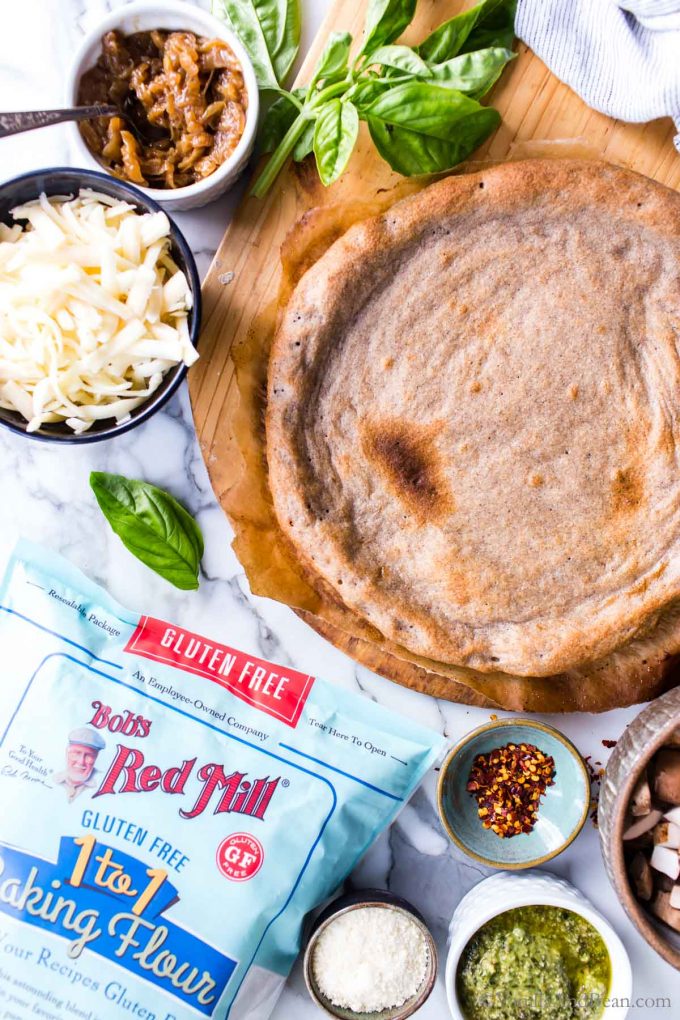
Gluten Free Sourdough Pizza Crust FAQs
Thin Crust or Thick Crust Pizza?
Depending on how you shape the dough will depend on whether you’ll create a thick or thin crust pizza. I typically go for a thinner crust by shaping the edges a little narrower (as shown in the pictures). However, for a thicker crust, shape the pizza a bit smaller and allow for a little bulk around the edges.
What Kind of Pizza Pan to Use?
To bake the pizza, you can use either a pizza stone and/or the back of a sheet pan or one of each. When baking multiple pizzas, preheating the pan or stone will help create a crispy crust. You can use either because they both produce similar results with sourdough gluten free pizza dough.
Is the Pizza Crust Freezer Friendly?
Yes! There are two ways to freeze: 1. Freeze the dough balls in freezer bags or freeze the par baked pizza crust. Freezing the dough is convenient, however, it looses some of its leavening power and the final texture of the dough is compromised. 2. Freeze the par baked crust. This is the method I prefer because it’s super easy to thaw, top and bake in short order.
Is Sourdough Pizza Crust Gluten Free?
Yes and no. It depends on the sourdough starter and flour used in the recipe. If gluten free flour is used to make a starter and pizza dough, then sourdough pizza crust is gluten free. However, if gluten full flour are used to make the starter and pizza dough, then the pizza crust is not gluten free.
Love gluten free sourdough discard recipes? Then you’ll enjoy my Gluten Free Sourdough Discard Pancakes and Waffles!
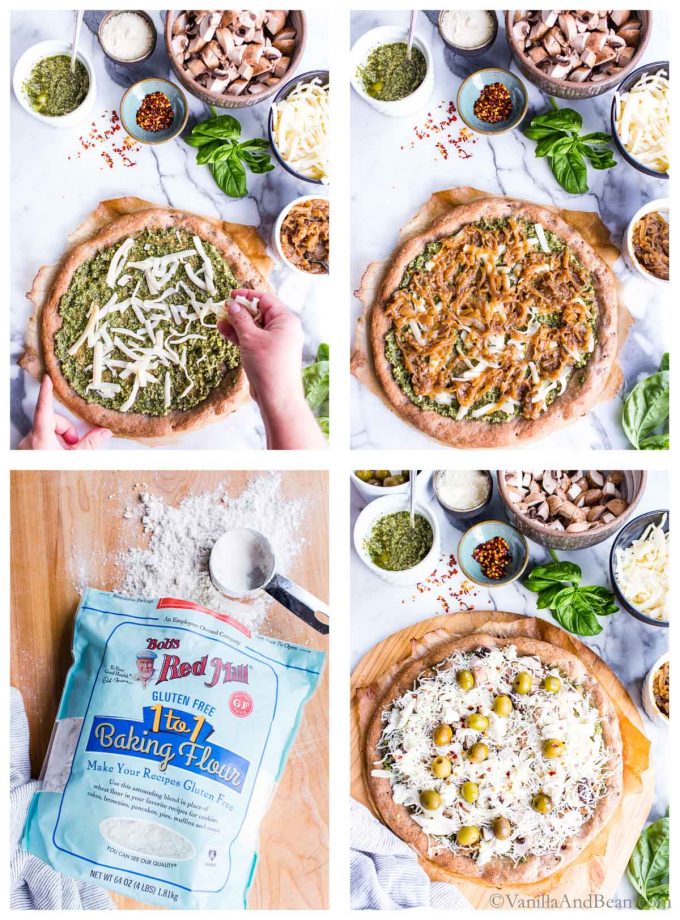
A Few Recipe Notes
- The gluten free pizza dough is par-baked meaning the crust is baked prior to piling on the sauce and toppings. I’ve made this recipe without par baking the gluten free pizza dough, but the crust didn’t finish baking by the time the toppings were done. So, after the crust is par-baked, add the pizza sauce or pesto and toppings.
- Shaping the gluten free pizza dough takes a little practice and finesse. Because the dough is wet, and you wet your hands in order to shape it (sans flour), it’s almost like trying to shape mashed potatoes into a pizza shape. The excess water will cook off, don’t worry.
- Par-baking the crust and finished pizza at 550 Fahrenheit contributes to a crisp outer crust and chewy interior. At that temperature, the assembled pizza will bake fast. Seven to nine minutes should do it!
- You’ll shape and bake the dough on parchment paper. Note that parchment paper isn’t generally rated for use over 500 Fahrenheit. So at 550 Fahrenheit, with any overhang, the paper will char and become brittle.
- A pizza peel makes transferring the shaped gluten free pizza dough (with parchment supporting it) to the preheated stone/pan a snap. I recommend it. However, if not using a peel, the shaped pizza dough can be slid off the back of another pan and onto the preheated stone/pan. Just be careful as the oven is very hot!
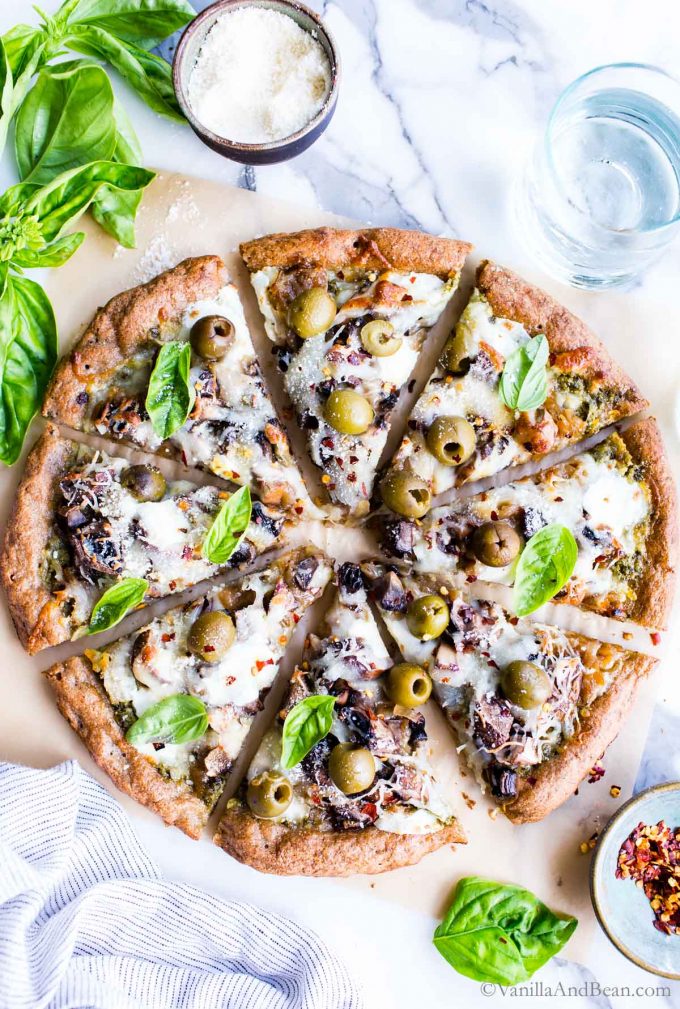
For more recipes using Bob’s Red Mill Gluten Free 1-to-1 Baking Flour and other fabulous ingredients head to their website.
More Gluten Free Sourdough Recipes to Love
- Seeded Multigrain Gluten Free Sourdough Bread
- Gluten Free Sourdough Pancakes
- Gluten Free Sourdough Waffles (blender!)
Gluten Free Sourdough Pizza Crust
Ingredients
- 1 cup (150 grams) Bob’s Red Mill Gluten Free 1-to-1 Baking Flour
- 1/3 cup (40 grams) Super Fine Almond Flour I use Bob's Red Mill
- 1/4 cup (30 grams) Tapioca Flour I use Bob's Red Mill
- 1 3/4 teaspoons Psyllium Husk Powder I use Terrasoul PHP *see note on brands
- 1 1/4 teaspoons Baking Powder
- 1 1/4 teaspoon Fine Sea Salt
- 1/2 teaspoon Quick Rise Yeast or Rapid Rise Yeast
- 1/2 cup (140 grams) Gluten Free Sourdough Discard stirred down
- 1 cup + 2 tablespoons (260 grams) Water 115 Fahrenheit (46 Celsius)
- 1 tablespoons Olive Oil + more for brushing the parchment paper
Instructions
Mix the Dough:
- In a medium mixing bowl whisk the gluten-free flour, almond flour, tapioca flour, psyllium husk powder, baking powder, salt, and yeast so that the ingredients are evenly distributed. Set aside.In a separate medium mixing bowl, whisk the sourdough discard, warm water and olive oil. Add the dry ingredients to the wet using a fork to incorporate the flour. The batter will begin to thicken. Use the fork to scrape the batter off your hands, then knead by hand, in the bowl, for two minutes.The dough will become thicker and remain sticky, almost like mashed potatoes. Scrape the excess dough off your fingers using a fork. Use a water moistened silicone spatula, scrape the bowl and smooth the dough on the surface into a dome. Cover the bowl with a damp tea towel and leave on the kitchen counter or warm area to rise for about 90-120 minutes. I recommend putting it in a turned off oven with the light on. The dough should rise to about 1 1/2 times its size and be fluffy/springy to the touch.
Prepare:
- While the Dough is Rising: a. Prepare a sheet of parchment paper by generously brushing olive oil on the parchment, one for each pizza. This is the base to shape and bake the crust on. Have a pizza peel or sheet pan standing by to slide the shaped dough on to for baking. b. Prepare the oven by placing an oven rack at the center and if making two pizzas, another rack two settings down (leaving enough room to slide the pizza on to the pan).Place sheet pan(s) and/or pizza stones on racks. Two crusts or pizzas can be baked at the same time. c. Prepare the ingredients for the pizza. Just before you're ready to divide and shape the dough, preheat the oven to 550 Fahrenheit (288 Celsius).
Divide the Dough:
- At this point, you'll only use water to shape the dough. Fill a shallow dish with water so you can wet your hands as you work with the dough. Do not use flour here (as traditionally done with glutenous dough). Moisten a work surface with water. Turn the dough out onto the moist work surface. Dip your fingertips and palms into the water and pat the dough into somewhat of a disk, then divide the dough into two equal pieces. Moisten your hands again and shape each piece into a rough ball by tucking the edges under. Set the dough balls on a water-moist work surface.
Shape the Dough:
- On the oiled parchment paper, set a pizza dough ball in the center. Dip your palm and fingertips into the water. Working with both fingertips and palms, start pressing in the center of the dough, working your way towards the edges in a circular pattern leaving an edge all around that is thicker than the base of the crust (you can play with this if you like a thicker crust). It will feel almost like trying to shape mashed potatoes! There may be a bit of occasional tearing, if so, wet your hands/fingertips and smooth those areas back together. Turn the parchment as you work the dough so that a pizza shape can be achieved. Continue, wetting your hands and smoothing over the dough with light pressure as needed so the dough does not stick to your hands and you shape it by smoothing the dough in circular motions and/or pinching to create the edges, then smoothing with moist fingers again. It's okay that the parchment gets a little wet. I make my crust thin on the bottom and go for an 11" crust – but you can play with this if you like a little thicker crust (10" pizza). Note: If you plan on freezing the par baked crust, you'll need to make the crust *thicker* on the bottom – more of a 10 inch crust, as it tends to become brittle/fragile in the freezer in areas where it's *too* thin. Wet a fork and dock the pizza with the tines of the fork about 10 times. Tear off any excess parchment paper so that it's flush with the pizza dough, leaving enough overhang to use as a handle if needed. *Note that parchment paper is generally rated for use under 500 Fahrenheit. So at 550 Fahrenheit, with any overhang, the paper will char and become brittle.
Par-Bake the Dough:
- Slide the shaped pizza dough onto a pizza peel or the back of a sheet pan using the parchment as a handle if needed. Open the oven and pull out the rack with the stone/pan. Slide the pizza dough onto the preheated pizza stone or back of the preheated pan. Sometimes the center puffs a bit during baking. Check the dough halfway through baking and if it has puffed in the center, use a knife to poke a small hole to let some of the steam out from under the pizza – use the knife to press it down to release the steam. Par-bake for 11-13 minutes or until the dough is golden brown around the edges and center. Remove from the oven. The parchment will be brittle at this point, and can be removed before baking the pizza. It may stick a little, so remove it carefully. Top the par baked crust with your favorite sauce or lemon basil pesto and toppings. Pictured is basil, mushrooms, artichokes, mozzarella, mixed Italian cheese and ripe green olives. To Freeze: The par baked crust may be frozen at this point. Allow the crust to cool completely, then store it in a freezer or plastic bag. Thaw at room temperature and carry on!
Bake the Pizza:
- Bake the assembled pizza on preheated stone or pan at 550 Fahrenheit (288 Celsius) for about 6-8 minutes or until the cheese has melted and sauce is bubbly – a little cheese blistering is okay! The pizza bakes fast at high heat, so keep an eye on it. Remove from oven and allow to rest for five minutes. Cut into 8 equal pieces.
Store the Pizza:
- Store pizza leftovers in a lidded container in the refrigerator for up to three days. Reheat at 350F for about 12 minutes.


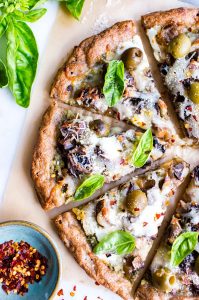

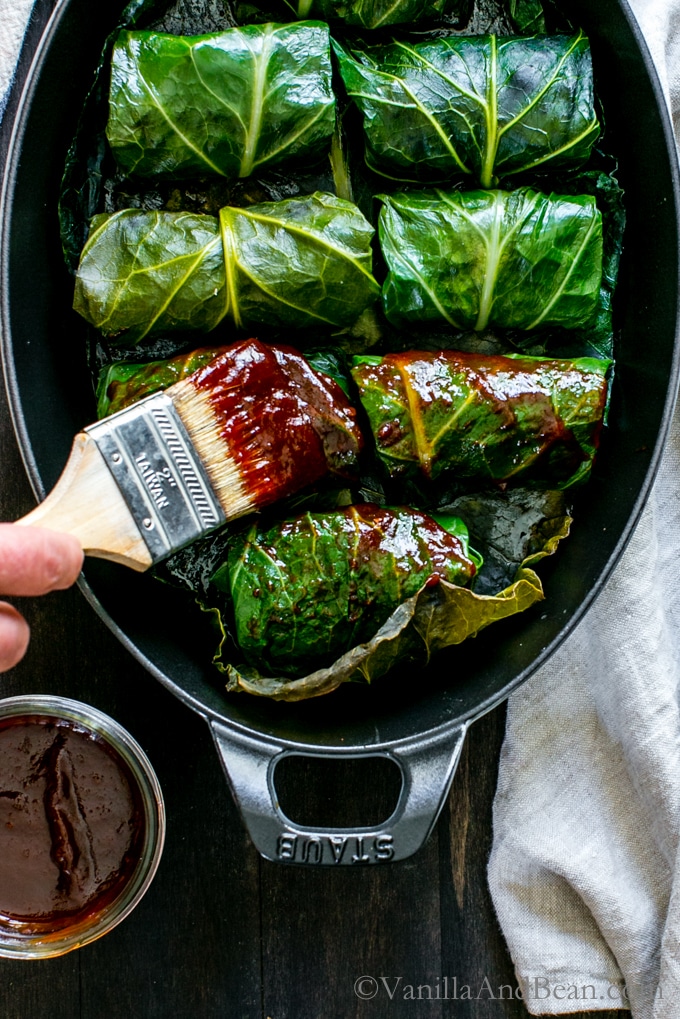
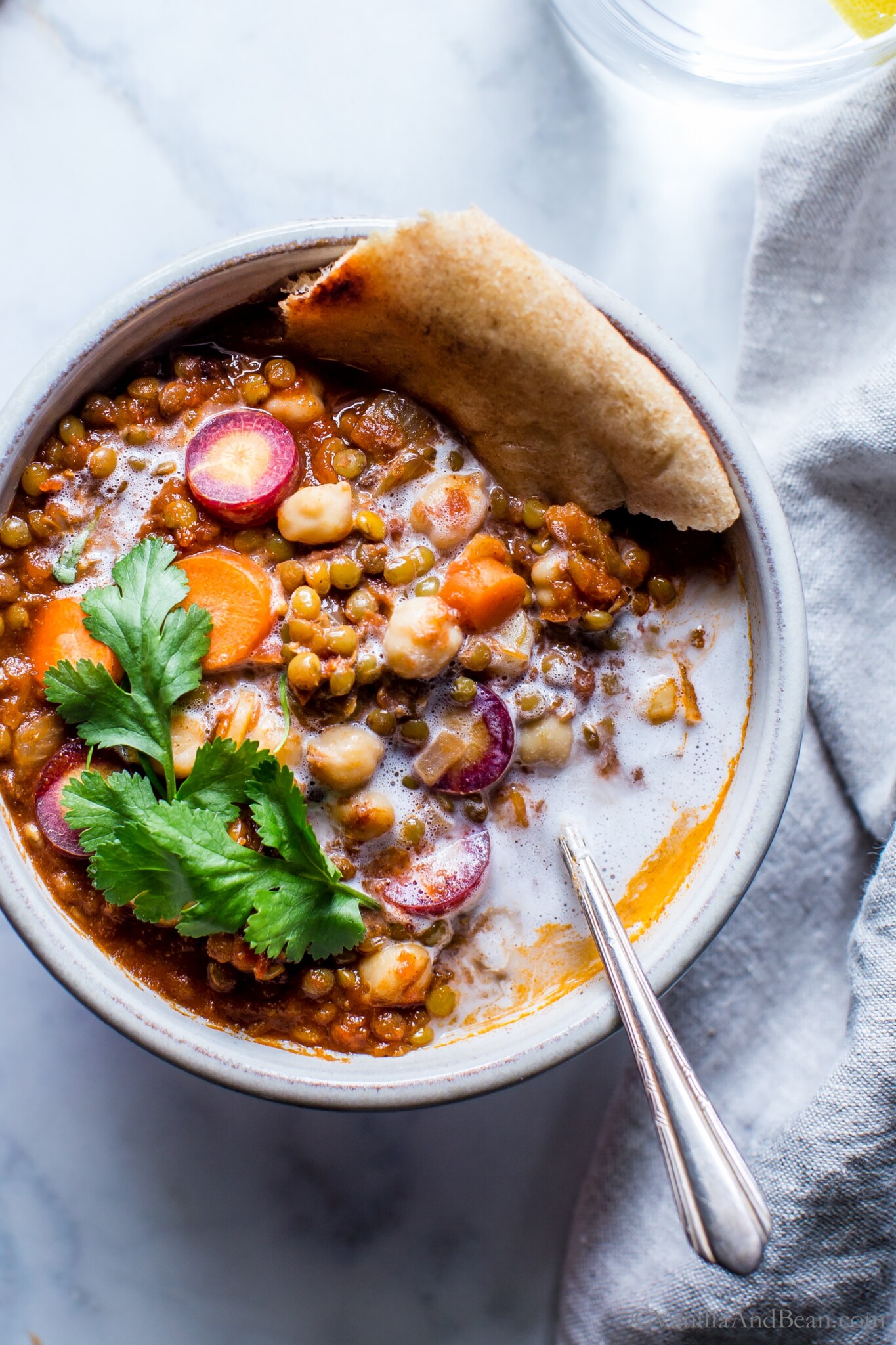
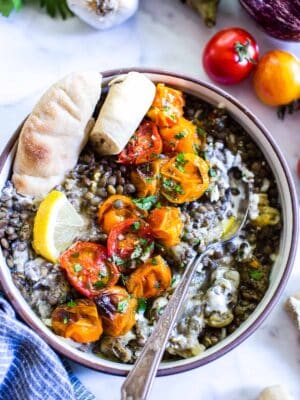
***** Recipe was extremely yummy…probably the best GF crust we ever had, however, our pizza stone, even though we tempered it to adjust to the heat, broke in 4 pieces as soon as I opened the oven door. From now on I am using my flat pizza cast iron flat skillet for this recipe. Can’t afford spending $60 plus dollars every time I want to create this incredible recipe. I am giving the recipe 5 stars but the pizza stone only 2.
Hi Patricia! Thank you for your note and giving the pizza a go. Interesting about the pizza stone. I’ve been using the same one for over 6 years… I’m wondering if there is a heat limitation from the manufacturer of your stone?
My pizza stone was from pampered chef. I almost cried.
Amazing. I made it into a focaccia bread. Great texture.
Love hearing this, Jude! Thank you for your note, five star review and giving the pizza a go!
Hi Traci,
Can the dough be prepped, separated, and then frozen and defrosted for later use?
Thanks,
Cecilia
Hi Cecilia! You can… here’s what to do: brush olive oil on the inside of a freezer bag or container. Gently place the dough into the bag and freeze for up to two weeks. Thaw in the refrigerator overnight to be shaped and bake as directed. The dough is best however, fresh.
Hi there, are you using cold discard from the fridge?
Hi Carla! Yes, use discard from the fridge.
Thanks! When recipes call for discard, is it always cold from the fridge? Does it need to be less than a week old?
It depends on the recipe. For my recipes, unless otherwise indicated, you can use it straight from the fridge. Time depends on several factors, but generally about one week is fine. Just be on the lookout for mold. If you see any or if the discard smells off, throw it out.
This looks amazing! Question about the starter. Could I use the starter after feeding it when it is doubled in size and omit the yeast? I usually make a regular sourdough pizza crust with the starter like that and get a great result. I’m new to gluten free and was wondering if my gluten free starter would be the same result in rise? Just curious to why you used the discard instead of a fed starter. Thanks!
Hi Deborah! A little background: while testing GF Sourdough Bread recipes, I found that in order for the bread to keep its shape, it needed the walls of a pan to hold up its structure. Otherwise the bread would fall flat (this using whole flours with little to no starches, like potato starch or tapioca starch). With this recipe, you can use a doubled in size starter. However, I’m not sure you can omit the yeast and still get the same result (there are no walls of a pan to ‘hold up’ the shape of the dough). If I recall, during my testing years ago, I got a better result (shaping and texture wise) using a combo of yeast and discard with the shorter rise time – as I attempted to make it like my regular sourdough pizza, but didn’t prefer the result (baking it in a similar way works, however). Last, I use discard instead of a fed starter in this recipe because the discard provides delicious flavor, and gives us a way to use discard rather than tossing it. Yeast allows us to enjoy pizza within about 2 hours rather than a day and a half. I hope this helps! Keep us posted if you experiment or give the recipe a go!
Hi,
Thank you so much for your detailed reply! I know that was a loaded question. All of this makes sense. I am new to gluten free baking so not familiar with working with these flours yet. I’m excited to try your recipe exactly the way it is tonight. I might do some experimenting later and I’ll definitely let you know how it turns out. I’m just grateful you offer GF pizza dough and bread recipes! That was one thing I knew I was going to feel a little FOMO about when becoming GF. Love all of your recipes and thanks again!
P.S. Oops, what I meant to say was that it I asked a complicated question not a loaded question.
Hands down the best GF pizza crust
recipe! Holds its shape nicely, taste and
texture is excellent. I substituted the
psyllium husk powder for equal parts
xantham gum and it still turned out fine (:
Hooray, Niki! Super happy to read your note, success and tip for xantham gum! Thank you for giving the recipe a go and sharing (it looked SO good on Pinterest!)
I use namaste bacon mix and arrowroot starch and I doubled it. My mix is very sticky like I touch my fingers to it and come away with a bunch of dough so there’s no way I could kneed it. I’m very tempted to add more flour, should I?
Hi Sara! Does the mix feel like mashed potatoes? If so, kneed the dough until it stiffens a bit… it wont feel like traditional dough kneeding, rather you’re just mushing and moving the ingredients. Unfortunately I’m not familiar with namaste or arrowroot starch in this recipe, so I’m not sure how those changes impact this dough. Please keep us posted!
Hi tracy! Thanks for your quick reply, I didn’t see it until after I finished. What I did was add 1/2 cup more of the Namaste gluten free perfect flour blend to the double recipe. It was still very sticky but I could work it with wet hands like you said when I shaped it. I sprinkled Italian seasoning on it. It turned out crispy and a little chewy like you said it was really good. With my sourdough I do a about three tablespoons less water than the flour I add. Thanks for the recipe I’ll definitely make it again.
Hooray! So happy to hear it worked out using Namaste blend. Thank you for sharing your tips, follow up and persevering!
Thank you! This was one of the best recipes I found and I will definitely keep making it. For others that wonder, another reason to make gluten-free is that if you have any autoimmune condition it’s recommend you go off gluten. Believe me I love the whole wheat texture in baking. This pizza crust stands up to it and is very good but not as much fun to make, LOL. Thanks for the encouragement.
This was very pleased! The best pizza crust recipe I have tried so far, gluten free or
wheat flour pizza. Thanks!
Hooray Joanne! Thank you for giving the pizza a go – gluten free or wheat flour – now that’s a tall complement! Isn’t the flavor SO nice?
interesting, I’m not really looking for GF, but I really like the subs of almond and tapioca flour just to get away from full blown traditional pizza crusts for the carb impact, so thank you!
Hi Traci, Your Gluten Free Pizza Looks Good… Unless you have Celiac Disease, why would you make Gluten-Free Pizza? Anyway it looks good and Healthy… Nathan
Hi Nathan! Thank you for your note! I wrote briefly about this in my blog post. To explain further, there are several reasons. 1. quite a few in the V&B community requested it after I developed other GF sourdough recipes and shared them on the blog. 2. I did a gluten free trial, for almost nine months and found I didn’t need to go GF. But during that time, I worked diligently to make GF sourdough recipes, to replace the sourdough gluten full recipes I once enjoyed. I shared them on the blog and a few have become some of the most made recipes on my site. As a blogger, I’m here to help people and if this is one way I can do it, then this is what I offer. 3. As a cook/baker, I appreciate the knowledge/skills/challenge baking gluten free offers so that I can prepare food for friends who are gluten free. Additionally, this is what I hear sometimes too from V&B readers. Cooks/bakers who aren’t celiac or gluten sensitive, but cook for those that are. I hope this helps!
I am in the process of making the sourdough starter and I just wanted to comment that I am very grateful that you have made these recipes. I have an issue that has been undiagnosed for 4 years now. I do not have celiac disease nor any kind of intestinal issues. My issues are numbness and tingling. However, the reason for telling you that is because even though I do not have celiac, whenever I eat gluten, it worsens my numbness and tingling exponentially. No idea why, but it does. So I am extremely grateful for your recipes. The store bought ones are awful. I am so excited to try all your recipes. Thank you!
Hi Kathy! Thank you for your note. I’m so sorry to hear about your undiagnosed symptoms, but it sounds like you’ve nailed it down! An inconvenience for sure, but it’s so good to know what’s helping. Thrilled to be a part of your journey, please keep us posted on your starter progress!
Numbness and tingling can be a sign of Vit B12 deficiency. If my memory serve me right, flour producers add vitamins to flour as without it, it draws from what a person has in storage. Maybe you need to have your B12 tested?